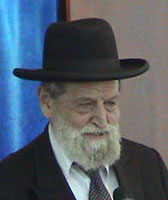Beit Midrash
- Sections
- Chemdat Yamim
- Parashat Hashavua
- Torah Portion and Tanach
- Shmot
- Pkudei
However, the sefer ends with the final three p’sukim that discuss another element of the cloud and the Mishkan – that the cloud stayed on top of the Mishkan until it was time for Bnei Yisrael to move, so that the removal of the cloud signaled the start of the next sojourn. At first glance, this looks anticlimactic and inappropriate for our sefer. The movement of the cloud as a sign to travel is discussed at length, where it "should be" – in Sefer Bamidbar in discussing all of the characteristics of the encampment and the travels (specifically, Bamidbar 9:15-23). In what way does this seemingly technical usage of the divine cloud teach us something fundamental about the Mishkan, which would make it appropriate to conclude the discussion?
The Seforno’s following observation gives us an opening to a solution. We do not find that there was a special cloud over the Mishkan during its many years in Eretz Yisrael, most prominently in Shiloh, nor over the Beit Hamikdash. The Kli Yakar makes another observation. Moshe was able to enter divine clouds (see Shemot 24:18). The reason he could not enter the Mishkan due to the Divine Presence was that the Divine Presence was separated from the cloud – the cloud was on top of the Mishkan; the Divine Presence was inside the Mishkan. Thus, in its "uncovered" form, Moshe could not be together with the Divine Presence. But why was there separation, and why only in the Mishkan in the desert?
Now perhaps we can see a special element of the Temple that existed only in the Mishkan. The Mishkan in the desert was not just a place for Hashem’s Presence to dwell, for the kohanim to do their service, and for other Jews to come for service and inspiration on occasion. The Mishkan in the encampment was a daily focal point of the personal and national life of the people. There was not a day in which there was no visible sign of this Presence – one lifted his eyes and looked to the middle of the encampment, and there was the divine cloud hovering over it. (This is parallel to a daily portion of divine bread that fell.) When it was time to travel, the message was again brought home. If the divine cloud is going elsewhere, then that is the place that the nation needed to be, because the nature of the people’s spiritual life was focused on the Mishkan. This is indeed a climactic element of the Mishkan!

“You Shall Do for Me a Sanctuary... Tabernacle”
Rabbi Yossef Carmel | 28 Shvat 5768

Parashat Hashavua: 137 and the Power of Uncertainty
Rabbi Yossef Carmel | Cheshvan 5786

Parashat Hashavua: How to Ensure a Future of Torah
Rabbi Yossef Carmel | Cheshvan 5786
























